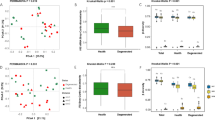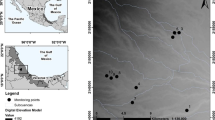Abstract
Tropical peat swamp forests are important and endangered ecosystems, although little is known of their microbial diversity and ecology. We used molecular and enzymatic techniques to examine patterns in prokaryotic community structure and overall microbial activity at 0-, 10-, 20-, and 50-cm depths in sediments in a peat swamp forest in Malaysia. Denaturing gradient gel electrophoresis profiles of amplified 16S ribosomal ribonucleic acid (rRNA) gene fragments showed that different depths harbored different bacterial assemblages and that Archaea appeared to be limited to the deeper samples. Cloning and sequencing of longer 16S rRNA gene fragments suggested reduced microbial diversity in the deeper samples compared to the surface. Bacterial clone libraries were largely dominated by ribotypes affiliated with the Acidobacteria, which accounted for at least 27–54% of the sequences obtained. All of the sequenced representatives from the archaeal clone libraries were Crenarchaeota. Activities of microbial extracellular enzymes involved in carbon, nitrogen, and phosphorus cycling declined appreciably with depth, the only exception being peroxidase. These results show that tropical peat swamp forests are unusual systems with microbial assemblages dominated by members of the Acidobacteria and Crenarchaeota. Microbial communities show clear changes with depth, and most microbial activity is likely confined to populations in the upper few centimeters, the site of new leaf litter fall, rather than the deeper, older, peat layers.





Similar content being viewed by others
References
Alvarez S, Guerrero MC (2000) Enzymatic activities associated with decomposition of particulate organic matter in two shallow ponds. Soil Biol Biochem 32:1941–1951
Anderson JAR (1983) The tropical peat swamps of western Malaysia. In: Gore, AJP (eds) Ecosystems of the world 4B, mires: swamp, bog, fen and moor. Regional studies. Elsevier, Amsterdam, pp 181–199
Barns SM, Takala SL, Kuske CR (1999) Wide distribution and diversity of members of the bacterial kingdom Acidobacterium in the environment. Appl Environ Microbiol 65:1731–1737
Barns SM, Cain EC, Sommerville L, Kuske CR (2007) Acidobacteria phylum sequences in uranium-contaminated subsurface sediments greatly expand the known diversity within the phylum. Appl Environ Microbiol 73:3113–3116
Basiliko N, Yavitt JB, Dees PM, Merkel SM (2003) Methane biogeochemistry and methanogen communities in two northern peatland ecosystems, New York State. Geomicrobiol J 20:563–577
Buckley DH, Graber JR, Schmidt TM (1998) Phylogenetic analysis of nonthermophilic members of the Kingdom Crenarchaeota and their diversity and abundance in soils. Appl Environ Microbiol 64:4333–4339
Chao A (1987) Estimating the population size for capture–recapture data with unequal catchability. Biometrics 43:783–791
Chan OC, Yang X, Fu Y, Feng Z, Sha L, Casper P, Zou X (2006) 16S rRNA gene analyses of bacterial community structures in the soils of evergreen broad-leaved forests in south-west China. FEMS Microbiol Ecol 58:247–259
Chin K-J, Lukow T, Conrad R (1999) Effect of temperature on structure and function of the methanogenic archaeal community in an anoxic rice field soil. Appl Environ Microbiol 65:2341–2349
Dedysh SN, Pankratov TA, Belova SE, Kulichevskaya IS, Liesack W (2006) Phylogenetic analysis and in situ identification of Bacteria community composition in an acidic Sphagnum peat bog. Appl Environ Microbiol 72:2110–2117
Dennis C, Aldhous P (2004) A tragedy with many players. Nature 430:396–398
Ferris MJ, Muyzer G, Ward DM (1996) Denaturing gradient gel electrophoresis profiles of 16S rRNA-defined populations inhabiting a hot spring microbial mat community. Appl Environ Microbiol 62:340–346
Freeman C, Liska G, Ostle NJ, Jones SE, Lock MA (1995) The use of fluorogenic substrates for measuring enzyme activity in peatlands. Plant Soil 175:147–152
Gorham E (1991) Northern peatlands: role in the carbon cycle and probable responses to climate warming. Ecol Appl 1:182–195
Hugenholtz P (2002) Exploring prokaryotic diversity in the genomic era. Genome Biol 3:reviews0003.1–reviews0003.8
Hugenholtz P, Goebel BM, Pace NR (1998) Impact of culture-independent studies on the emerging phylogenetic view of bacterial diversity. J Bacteriol 180:4765–4774
Jackson CR, Vallaire SC (2007) Microbial activity and decomposition of fine particulate organic matter in a Louisiana cypress swamp. J N Am Benthol Soc 26:742–752
Jackson CR, Foreman CM, Sinsabaugh RL (1995) Microbial enzyme activities as indicators of organic matter processing rates in a Lake Erie coastal wetland. Freshwater Biol 34:329–342
Jackson CR, Langner HW, Donahoe-Christiansen J, Inskeep WP, McDermott TR (2001) Molecular analysis of microbial community structure in an arsenite-oxidizing acidic thermal spring. Environ Microbiol 3:532–542
Jackson EF, Echlin HL, Jackson CR (2006) Changes in the phyllosphere community of the resurrection fern, Polypodium polypodioides, associated with rainfall and wetting. FEMS Microbiol Ecol 58:236–246
Jacobs M (1988) The tropical rainforests: a first encounter. Springer, Berlin
Janssen PH (2006) Identifying the dominant soil bacterial taxa in libraries of 16S rRNA and 16S rRNA genes. Appl Environ Microbiol 72:1719–1728
Janssen PH, Yates PS, Grinton BE, Taylor PM, Sait M (2002) Improved culturability of soil bacteria and isolation in pure culture of novel members of the divisions Acidobacteria, Actinobacteria, Proteobacteria, and Verrucomicrobia. Appl Environ Microbiol 68:2391–2396
Jauhiainen J, Takahashi H, Heikkinen JEP, Martikainen PJ, Vasanderet H (2005) Carbon fluxes from a tropical peat swamp forest floor. Glob Chang Biol 11:1788–1797
Kemp PF, Aller JY (2004) Estimating prokaryotic diversity: when are 16S rDNA libraries large enough? Limnol Oceanogr Methods 2:114–125
Kotsyurbenko OR, Chin K-J, Glagolev MV, Stubner S, Simankova MV, Nozhevnikova AN, Conrad R (2004) Acetoclastic and hydrogenotrophic methane production and methanogenic populations in acidic West-Siberian peat bogs. Environ Microbiol 6:1159–1173
Ludwig W, Strunk O, Westram R, Richter L, Meier H, Yadhukumar BA, Lai T, Steppi S, Jobb G, Förster W, Brettske I, Gerber S, Ginhart AW, Gross O, Grumann S, Hermann S, Jost R, König A, Liss T, Lüßmann R, May M, Nonhoff B, Reichel B, Strehlow R, Stamatakis A, Stuckmann N, Vilbig A, Lenke M, Ludwig T, Bode A, Schleifer K-H (2004) ARB: a software environment for sequence data. Nucleic Acids Res 32:1363–1371
Lueders T, Friedrich M (2000) Archaeal population dynamics during sequential reduction processes in rice field soil. Appl Environ Microbiol 66:2732–2742
Maltby E, Immirzi CP (1993) Carbon dynamics in peatlands and other wetland soils—regional and global perspectives. Chemosphere 27:999-1023
McGill WB, Cole CV (1981) Comparative aspects of cycling of organic C, N, S, and P through soil organic matter. Geoderma 26:267–286
Ochsenreiter T, Selesi D, Quaiser A, Bonch-Osmolovskaya L, Schleper C (2003) Diversity and abundance of Crenarchaeota in terrestrial habitats studied by 16S RNA surveys and real time PCR. Environ Microbiol 5:787–797
Olander LP, Vitousek PM (2000) Regulation of soil phosphatase and chitinase activity by N and P availability. Biogeochem 49:175–190
Oline DK, Schmidt SK, Grant MC (2006) Biogeography and landscape-scale diversity of the dominant Crenarchaeota of soil. Microb Ecol 52:480–490
Page SE, Siegert F, Rieley JO, Boehm H-DV, Jaya A, Limin S (2002) The amount of carbon released from peat and forest fires in Indonesia during 1997. Nature 420:61-65
Page SE, Wust RAJ, Weiss D, Rieley JO, Shotyk W, Limin S (2004) A record of late Pleistocene and Holocene carbon accumulation and climate change from an equatorial peat bog (Kalimantan, Indonesia): implications for past, present and future carbon dynamics. J Quat Sci 19:625-635
Pind A, Freeman C, Lock MA (1994) Enzymic degradation of phenolic materials in peatlands—measurement of phenol oxidase activity. Plant Soil 159:227–231
Qualls RG, Haines BL (1990) The influence of humic substances on the aerobic decomposition of submerged leaf litter. Hydrobiology 206:133–138
Rieley JO, Ahmad-Shah AA, Brady MA (1996) The extent and nature of tropical peat swamps. In: Maltby, E, Immirzi, CP, Safford, RJ (eds) Tropical lowland peatlands of Southeast Asia. IUCN, Gland, Switzerland, pp 17–53
Sundh I, Nilsson M, Borga P (1997) Variation in microbial community structure in two boreal peatlands as determined by analysis of phospholipid fatty acid profiles. Appl Environ Microbiol 63:1476–1482
Thawai C, Tanasupawat S, Itoh T, Suwanborirux K, Suzuki K, Kudo T (2005) Micromonospora eburnea sp. nov., isolated from a Thai peat swamp forest. Int J Syst Evol Microbiol 55:417–422
van der Werf GR, Randerson JT, Collatz GJ, Giglio L, Kasibhatla PS, Avelino A, Olsen SC, Kasischke ES (2004) Continental-scale partitioning of fire emissions during the 1997 to 2001 El Ninõ/La Ninã Period. Science 303:73-76
Voglmayr H, Yule CM (2006) Polyancora globosa gen. sp. nov., an aeroaquatic fungus from Malaysian peat swamp forests. Mycol Res 110:1242–1252
Wantzen KM, Yule CM, Mathooko JM, Pringle CM (2007) Organic-matter processing in tropical streams. In: Dudgeon, D (eds) Tropical stream ecology. Academic, San Diego, CA
Wells A, Yule CM (2008) The caddisflies (Trichoptera) from a tropical peat swamp in Selangor, Peninsular Malaysia, including two new species. Aquatic Insects 30:69–76
Whitmore TC (1984) Tropical rainforests of the far east. Clarendon, Oxford
Whitten T, Damanik SJ, Anwar J, Hisyam N (2000) The ecology of Sumatra. Periplus, Singapore
Wright AL, Reddy KR (2001) Phosphorus loading effects on extracellular enzyme activity in Everglades wetland soils. Soil Sci Soc Am J 65:588–595
Xie X, Xiao S, He Z, Liu J, Qiu G (2007) Microbial populations in acid mineral bioleaching systems of Tong Shankou Copper Mine, China. J Appl Microbiol 103:1227–1238
Zhang T, Fang HHP (2000) Digitization of DGGE (denaturing gradient gel electrophoresis) profile and cluster analysis of microbial communities. Biotechnol Lett 22:399–405
Acknowledgments
M.D. Barrows and S.E. Young assisted with enzyme assays and molecular work. Funding for this work was provided to C.R.J. by through an O.R.S.P. faculty research award from The University of Mississippi and to C.M.Y. through a Monash University research grant.
Author information
Authors and Affiliations
Corresponding author
Rights and permissions
About this article
Cite this article
Jackson, C.R., Liew, K.C. & Yule, C.M. Structural and Functional Changes with Depth in Microbial Communities in a Tropical Malaysian Peat Swamp Forest. Microb Ecol 57, 402–412 (2009). https://doi.org/10.1007/s00248-008-9409-4
Received:
Accepted:
Published:
Issue Date:
DOI: https://doi.org/10.1007/s00248-008-9409-4




